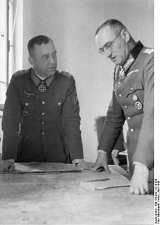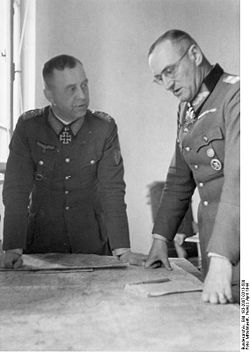
Otto Wöhler
Encyclopedia
Otto Wöhler was a German
general
of infantry
, serving during World War I
and World War II
and recipient of the Knight's Cross with Oak Leaves
. The Knight's Cross of the Iron Cross and its higher grade Oak Leaves was awarded to recognise extreme battlefield bravery or successful military leadership.
 Wöhler fought in World War I as a lieutenant and served in the post-war Reichsheer. A seasoned general staff officer, he had caught the attention of Field Marshal Erich von Manstein
Wöhler fought in World War I as a lieutenant and served in the post-war Reichsheer. A seasoned general staff officer, he had caught the attention of Field Marshal Erich von Manstein
, who made him his chief of staff when Manstein was appointed to command 11th Army. Wöhler served with Manstein until April 1942 when he was assigned as chief of staff for Army Group Center under Field Marshal Günther von Kluge
. Wöhler’s first combat command was I. Armeekorps which he led from April to August 1943, before being given command of 8th Army on 22 August 1943. Field Marshal von Manstein, whose Army Group South included 8th Army, was very pleased with this appointment as Wöhler had fought with distinction and skill during the summer and fall of 1943. His cool-headedness was considered a crucial asset at that stage and later on the Eastern Front.
According to Heinz Guderian's memories, when Heeresgruppe Süd
,which he commanded, destroyed Russian bridge-head over Hron river by 22.February 1945, Hitler said "Wöhler may not be National-Socialist, but at least he is he-man."
As with every other German senior officer, Wöhler was investigated by the Allies after the war and was then implicated in Einsatzgruppe activities while serving as Chief of Staff of 11th Army in early 1942. He was tried by a U.S. Military Tribunal at Nuremberg
("OKW Case
" No. XII) and then sentenced to 8 years imprisonment in October 1948. He was released in autumn 1950.
Until his death Otto Wöhler participated in many functions and as patron of civic organizations in his home community of Burgwedel. He also created a charitable foundation that inherited his estate. He is buried next to his only child, a son, who died in the Baltic during World War II as a naval cadet.
Germany
Germany , officially the Federal Republic of Germany , is a federal parliamentary republic in Europe. The country consists of 16 states while the capital and largest city is Berlin. Germany covers an area of 357,021 km2 and has a largely temperate seasonal climate...
general
General
A general officer is an officer of high military rank, usually in the army, and in some nations, the air force. The term is widely used by many nations of the world, and when a country uses a different term, there is an equivalent title given....
of infantry
Infantry
Infantrymen are soldiers who are specifically trained for the role of fighting on foot to engage the enemy face to face and have historically borne the brunt of the casualties of combat in wars. As the oldest branch of combat arms, they are the backbone of armies...
, serving during World War I
World War I
World War I , which was predominantly called the World War or the Great War from its occurrence until 1939, and the First World War or World War I thereafter, was a major war centred in Europe that began on 28 July 1914 and lasted until 11 November 1918...
and World War II
World War II
World War II, or the Second World War , was a global conflict lasting from 1939 to 1945, involving most of the world's nations—including all of the great powers—eventually forming two opposing military alliances: the Allies and the Axis...
and recipient of the Knight's Cross with Oak Leaves
Knight's Cross of the Iron Cross
The Knight's Cross of the Iron Cross was a grade of the 1939 version of the 1813 created Iron Cross . The Knight's Cross of the Iron Cross was the highest award of Germany to recognize extreme battlefield bravery or successful military leadership during World War II...
. The Knight's Cross of the Iron Cross and its higher grade Oak Leaves was awarded to recognise extreme battlefield bravery or successful military leadership.
Career

Erich von Manstein
Erich von Manstein was a field marshal in World War II. He became one of the most prominent commanders of Germany's World War II armed forces...
, who made him his chief of staff when Manstein was appointed to command 11th Army. Wöhler served with Manstein until April 1942 when he was assigned as chief of staff for Army Group Center under Field Marshal Günther von Kluge
Günther von Kluge
Günther Adolf Ferdinand “Hans” von Kluge was a German military leader. He was born in Posen into a Prussian military family. Kluge rose to the rank of Field Marshal in the Wehrmacht. He was also a recipient of the Knight's Cross of the Iron Cross with Oak Leaves and Swords...
. Wöhler’s first combat command was I. Armeekorps which he led from April to August 1943, before being given command of 8th Army on 22 August 1943. Field Marshal von Manstein, whose Army Group South included 8th Army, was very pleased with this appointment as Wöhler had fought with distinction and skill during the summer and fall of 1943. His cool-headedness was considered a crucial asset at that stage and later on the Eastern Front.
According to Heinz Guderian's memories, when Heeresgruppe Süd
Army Group South
Army Group South was the name of a number of German Army Groups during World War II.- Poland campaign :Germany used two army groups to invade Poland in 1939: Army Group North and Army Group South...
,which he commanded, destroyed Russian bridge-head over Hron river by 22.February 1945, Hitler said "Wöhler may not be National-Socialist, but at least he is he-man."
As with every other German senior officer, Wöhler was investigated by the Allies after the war and was then implicated in Einsatzgruppe activities while serving as Chief of Staff of 11th Army in early 1942. He was tried by a U.S. Military Tribunal at Nuremberg
Nuremberg
Nuremberg[p] is a city in the German state of Bavaria, in the administrative region of Middle Franconia. Situated on the Pegnitz river and the Rhine–Main–Danube Canal, it is located about north of Munich and is Franconia's largest city. The population is 505,664...
("OKW Case
High Command Trial
The High Command Trial was the last of the twelve trials for war crimes the U.S. authorities held in their occupation zone in Germany in Nuremberg after the end of World War II. These twelve trials were all held before U.S...
" No. XII) and then sentenced to 8 years imprisonment in October 1948. He was released in autumn 1950.
Until his death Otto Wöhler participated in many functions and as patron of civic organizations in his home community of Burgwedel. He also created a charitable foundation that inherited his estate. He is buried next to his only child, a son, who died in the Baltic during World War II as a naval cadet.
Awards
- 1914 Iron CrossIron CrossThe Iron Cross is a cross symbol typically in black with a white or silver outline that originated after 1219 when the Kingdom of Jerusalem granted the Teutonic Order the right to combine the Teutonic Black Cross placed above a silver Cross of Jerusalem....
- 2nd Class (29 September 1914)
- 1st Class (17 September 1916)
- House Order of HohenzollernHouse Order of HohenzollernThe House Order of Hohenzollern was an order of chivalry of the House of Hohenzollern. It was both a military and a civil award...
with Swords - 1939 Clasps to the Iron CrossIron CrossThe Iron Cross is a cross symbol typically in black with a white or silver outline that originated after 1219 when the Kingdom of Jerusalem granted the Teutonic Order the right to combine the Teutonic Black Cross placed above a silver Cross of Jerusalem....
- 2nd Class (19 September 1939)
- 1st Class (4 October 1939)
- German CrossGerman CrossThe German Cross was instituted by Adolf Hitler on 17 November 1941 as an award ranking higher than the Iron Cross First Class but below the Knight's Cross of the Iron Cross respectively ranking higher than the War Merit Cross First Class with Swords but below the Knight's Cross of the War Merit...
in Gold (26 January 1942) - Knight's Cross of the Iron Cross with Oak LeavesKnight's Cross of the Iron CrossThe Knight's Cross of the Iron Cross was a grade of the 1939 version of the 1813 created Iron Cross . The Knight's Cross of the Iron Cross was the highest award of Germany to recognize extreme battlefield bravery or successful military leadership during World War II...
- Knight's Cross (14 August 1943)
- 671st Oak Leaves (28 November 1944)
- Order of Michael the BraveOrder of Michael the BraveThe Order of Michael the Brave is Romania's highest military decoration, instituted by King Ferdinand I during the early stages of the Romanian Campaign of World War I, and was again awarded in World War II...
3rd and 2nd Class - Mentioned three times in the WehrmachtberichtWehrmachtberichtThe Wehrmachtbericht was a daily radio report on the Großdeutscher Rundfunk of Nazi Germany, published by the Oberkommando der Wehrmacht regarding the military situation on all fronts of World War II....
(12 August 1943; 8 May 1944; 30 October 1944)

